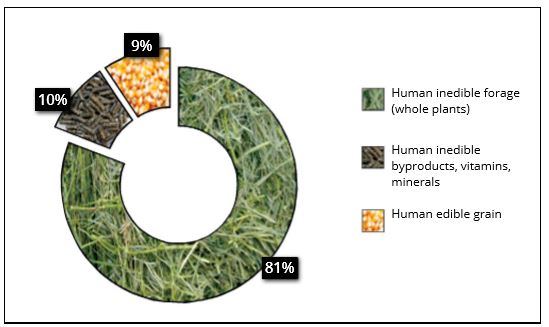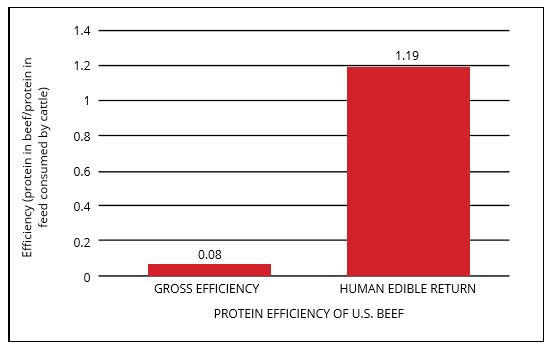Fact Sheet
Tough Questions About Beef Sustainability:
How Does Beef Fit into a Sustainable Food System?
Sara E. Place, Ph.D. | National Cattlemen’s Beef Association, a contractor to the Beef Checkoff
The UN Food and Agriculture Organization defines a sustainable food system as “a food system that delivers food security and nutrition for all in such a way that the economic, social and environmental bases to generate food security and nutrition for future generations are not compromised.2” Discussions related to the sustainability of our food system sometimes include arguments to reduce or abandon animal proteins with a particular focus on beef, because of its higher environmental footprint relative to other foods.3, 4 While environmental footprints (e.g., water and carbon footprints) are useful tools to benchmark the sustainability of an individual food industry or commodity, like beef, they are also unable to capture all the relevant components of a sustainable food system.
Multiple factors important to a sustainable food system that are not captured in environmental footprints include:
- Cattle can convert human-inedible feedstuffs into high quality human-edible protein.5
- Cattle consume forages/roughages (high-fiber plant feeds) that are grown on lands unsuitable for cultivation, thereby expanding the land base available for food production.6
- Cattle consume byproduct feeds from the food, fiber, and biofuels industries.6
- Integrating cattle into row-crop plant agriculture systems (e.g., grazing corn stalks after harvesting corn, grazing winter wheat that is subsequently harvested for human-use grain) can have environmental and socioeconomic sustainability benefits.7
- Beef cattle operations represent over 30% of the farms in the United States8, and thus beef cattle producers play an important role in the agricultural economy and the social fabric of rural America.
The unique biology of cattle contributes both to beef’s role in a sustainable food system and its environmental footprint.
Beef cattle are ruminant animals, which means they have a specialized stomach that contains four compartments. The largest of these compartments is called the rumen (hence, ruminants), which is home to trillions of microscopic bacteria, protozoa, and fungi. The trillions of microorganisms in the rumen of cattle and the host animal have a mutually beneficial relationship. The microbes are provided a warm, moist environment and a constant food supply from the feeds, enabling access to nutrients within the feeds that would otherwise be indigestible without the actions of the microorganisms.
Because of the unique biology of cattle, they fill an important role in our food system and the U.S. bio-economy by using human-inedible feeds or eating things that people cannot (Figure 1).9 Human-inedible feeds for cattle include the plants cattle eat on range and pasture lands unsuitable for cultivated agriculture (e.g., the 770 million acres of rangeland10 in the United States), and byproducts from the biofuels, fiber, and human food industries. By using byproducts that would otherwise go to waste, cattle are enhancing the sustainability of other industries. For example, cattle eat distillers grains from the corn ethanol industry, cottonseed that is a byproduct of cotton production, and beet pulp that is a byproduct of sugar beet production.

Figure 1. Life cycle feed intake of a grain-finished beef animal in the United States.9 Over 90% of the lifetime feed intake of beef cattle is not in competition with the human food supply.
The relative difference in the human nutritional value of the feeds cattle eat versus the human nutritional value of beef can be substantial. This means cattle are acting as “upcyclers” in our food system: rather than simply recycling, cattle are upgrading human inedible plant proteins and food waste into high-quality protein and essential micronutrients, such as B vitamins. In some U.S. grain-finished beef production systems, more human-edible protein is generated in the form of beef than cattle consume in the form of feed (Figure 2).6 Even when cattle are consuming human-edible feeds, such as corn grain, they are upgrading plant proteins to more complete and digestible proteins for humans. For example, the digestible indispensable amino acid score of beef is 2.6 times greater than corn grain,11 because the protein in beef is more bioavailable and contains a balance of the essential amino acids humans must consume in their diet.

Figure 2. Efficiency of protein conversion by U.S. beef production expressed two ways.6 Gross efficiency was calculated as outputs of human-edible protein in the form of beef divided by total protein feed inputs (i.e., no consideration given for if the protein in feed was human-edible, like corn, or inedible, like grass). Human-edible return was calculated as outputs of human edible protein in the form of beef divided by human-edible protein feed inputs. The value of 1.19 indicates more human-edible protein is returned from U.S. beef production than the beef cattle consume (i.e., beef cattle are a net source of protein to the human food supply).
Bottom Line: Beef cattle play a unique role in a sustainable food system by upcycling – they consume plants and byproduct feeds of lower value and upgrade them to high-quality protein. Additionally, cattle can graze and consume feeds that are grown on land that is unsuitable for cultivation, thereby expanding the land base available for food production.
References
- Foley, J.A., N. Ramankutty, K.A. Brauman, E.S. Cassidy, J.S. Gerber, M. Johnston, N.D. Mueller, C. O’Connell, D.K. Ray, P.C. West, C Balzer, E.M. Bennett, S.R. Carpenter, J. Hill, C. Monfreda, S. Polasky, J. Rockström, J. Sheehan, S. Seibert, D. Tilman, and D.P.M. Zaks. Solutions for a cultivated planet. 2011. Nature. 478:337-342.
- HLPE. 2014. Food losses and waste in the context of sustainable food systems. A report by the High Level Panel of Experts on Food Security and Nutrition of the Committee on World Food Security, Rome, 2014.
- Eshel, G., A. Shepon, E. Noor, and R. Milo. 2016. Environmentally optimal, nutritionally aware beef replacement plant-based diets. Environ. Sci. Technol. 50:8164-8168.
- Clark, M. and D. Tilman. 2017. Comparative analysis of environmental impacts of agricultural production systems, agricultural input efficiency, and food choice. Environ. Res. Letters.12:064016.
- Oltjen, J.W. and J.L. Beckett. 1996. Role of ruminant livestock in sustainable agricultural systems. Journal of Animal Science. 74: 1406-1409.
- Council for Agricultural Science and Technology (CAST) 1999. Animal agriculture and global food supply. Task force report No. 135 July 1999, Department of Animal Science, University of California, Davis, CA, USA.
- Sulc, R.M. and A.J. Franzluebbers. 2014. Exploring integrated crop-livestock systems in different ecoregions of the United States. Europ. J. Agronomy. 57:21-30.
- USDA. 2014. 2012 Census of Agriculture. United States Summary and State Data. Available at: https://www.agcensus.usda.gov/Publications/2012/Full_Report/Volume_1,_Chapter_1_US/usv1.pdf (accessed August 17, 2017).
- National Academies of Sciences, Engineering, and Medicine. 2016. Nutrient Requirements of Beef Cattle, Eight Revised Edition. Washington, DC: The National Academies Press.
- Sustainable Rangelands Roundtable. 2008. Sustainable Rangelands Ecosystem Goods and Services. Available at: http://sustainablerangelands.org/pdf/Ecosystem_Goods_Services.pdf (accessed August 17, 2017).
- Ertl, P. W. Knaus, and W. Zollitsch. 2016. An approach to including protein quality when assessing the net contribution of livestock to human food supply. Animal. 10:1883-1889.
- Myhre, G., D. Shindell, F.-M. Bréon, W. Collins, J. Fuglestvedt, J. Huang, et al. 2013. Anthropogenic and natural radiative forcing. In: T.F. Stocker, D. Qin, G.-K. Plattner, M.M.B. Tignor, S.K. Allen, J. Boschung, et al., editors, Climate change 2013: The physical science basis. Contribution of Working Group I to the Fifth Assessment Report of the Intergovernmental Panel on Climate Change. Cambridge Univ. Press, Cambridge, UK and New York.
Available at: https://www.ipcc.ch/report/ ar5/wg1/ (accessed 5 May 2017). - Battagliese, T., J. Andrade, R. Vinas, K. Stackhouse-Lawson, C. A. Rotz, and J. Dillon.
2015. U.S. Beef – Phase 2 Eco-efficiency Analysis.
http://www.beefresearch.org/CMDocs/BeefResearch/Sustainability%20Completed%20Project%20Summaries/BASF_NCBA%20US%20Beef%20Industry%20Phase2_%20NSF%20EEA%20Analysis%20Report_FINAL.pdf - EPA. 2017. Inventory of U. S. Greenhouse Gas Emissions and Sinks: 1990-2015. U. S. Environmental Protection Agency, Washington, D. C.
- U.N. Food and Agriculture Organization. FAOSTAT Database – Food and agricultural data. Available at: http://www.fao.org/faostat/en/#home (accessed August 17, 2017).
- USDA NASS. 2017. Statistics by Subject. Available at: https://www.nass.usda.gov/Statistics_by_Subject/index.php?sector=ANIMALS&PRODUCTS (accessed August 17, 2017).